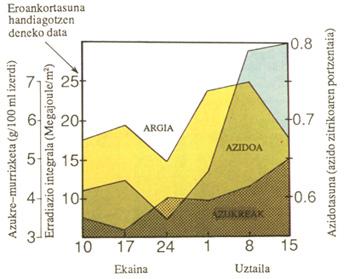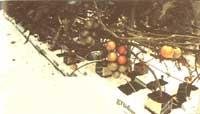Unflavored tomato

“From its origins to our days, the most spectacular are t-shirts, suitable for transport, resistant to diseases and pesticides and apparently healthy.” In addition, “they are fleshy, but without juice or flavor. Tomato is a decorative element that serves to dispose of chopped or entirely next to the plate”.
This denunciation, taken from the prestigious newspaper “Washington Post”, reflects what has been said for years by many tomatists. The red color, round, consistent and good buy are the essential characteristics to be able to sell the tomatoes. The taste seems not to participate much in the business.
About fifty years ago the greenhouses had wooden frames and small crystals. The farmers filled the coal boilers by hand and distributed the fertilizers by hand. In normal years, 100 tons of tomato per hectare were collected. Currently, the use of aluminum frames allows the placement of crystals between 1 and 3 meters wide, allowing greater lighting of the plants. Heat is often obtained automatically.
The tomato crop raised on the ground is a curiosity. Current commercial growers grow tomato plants in carbon compound fertilizers or landless crops. They control by computer when to water plants, when to fertilize them and when to add carbon dioxide to the greenhouse atmosphere. With more than 400 tons per hectare, the productivity increase is remarkable.
Consumers, both in Europe and North America, complain that tomatoes are not as before. The remedy is in the hands of researchers, who without increasing costs can analyze what ingredients the tomato flavor has.

The taste of any food is the reaction of a combination of substances. “Volatile smokers” are organic substances with low boiling point. The flyers are in very small quantities. In addition, we have flavor ingredients that we feel with the tongue and the palate. The smell of fresh tomato comes from the fruit, more than from the fruit itself, and from the sepals around the stems. The tomato bark has no pores, lenticels. Therefore, volatile smelters cannot escape. If we divide the fruit by putting the fabric in sight, we can extract and concentrate the following aroma ingredients.
At the same time, the enzymes present in the affected cells are released to be able to confuse them with the appropriate substrates, so that they quickly alter the identity of certain components. The smell of tomato consists of more than 400 substances, although none of these elements resemble the smell of ripe tomato. The taste of tomato is therefore a combination of flavour and smell ingredients, somewhat altered in the structure of its tissue and in the amount of juice. All this tells us that we are eating tomato (and did not come).

In general, we can identify four basic flavors in foods: acidity, salinity, bitterness and sweetness. Sugars and acids make up most of the flavor. Almost all sugars are glucose and fructose and between acids, especially malic in immature tomatoes and citric in adults.
Different studies have been conducted to determine the degree of taste and smell impairment of acid and sugar changes. The researchers conclude that the interaction between the factors is complex but that the best fruits are of high concentrations of sugars and acids.
Fly-sniffers are important both for themselves and for their interaction with sugars and acids, but the taste of tomato depends largely on at least the flavor ingredients. Researchers working to resurrect flavored tomato could do nothing to manipulate the basic level of the aromatic flyers, since it is at least one of the characteristics of the tomato variety itself.
The amount of sugar in the tomato crop that needs a long period of growth (8-9 months) depends on the sunlight that the plant receives during that time, with a slight rise after a few sunny days and a slight decrease after cloudy weather. Light is one of the most important simple elements that delimit the carbon hydrate of the leaves and is the source of almost all the fruit sugar. The cultivation, in addition to ensuring that the plants receive maximum light and keep the leaves in healthy conditions, has limited the possibility of increasing the amount of sugar from the tomato harvest.

Several researchers analyze the movement of solutes through the plant to reach the fruit and how they accumulate in it. The proportion between dry matter and water present in the fruit is important and not only for the taste of tomato. In the industry, the most important part of the fruit is curd and water is a waste. With the planting of a more "dry" fruit, the industry can advance millions of pesetas a year. One way to limit the amount of fruit water is to increase the osmotic pressure of irrigation.
For the plant to internalize the water it needs and maintain the osmotic gradient, it must increase its osmotic pressure, which makes accumulating solutes. Other researchers, in collaboration with scientists from the British Minister of Agriculture, work to increase the salinity of water used in irrigation of tomatoes planted in landless soil. This hardly alters the amount of solid matter of the entire crop, but now that the fruit has less water, the ingredients are more concentrated.

The addition of salt to the basic food elements slightly increases the production and increases the concentration of ingredients that determine the flavor. Increasing salt concentration improves quality, but production decreases. In most commercial greenhouses, increased salinity is used to produce flavored tomatoes.
If we divide the tomato in half, the inner tissues are of two types: walls (developed from the ovary and giving consistency to the fruit) and liquid contents of the holes (or lobes). When the fruit arrives, the seeds of the lobes hang in a translucent gel. The walls have at least 20% more sugars than the lobe rooms and 40% more acidic than the surrounding tissue. When we bake a tomato, normally before sweetness we taste acidity.
You cannot taste sugar without breaking tissue with your teeth. The structure of the tomato also has its part in the flavor. Most British farmers and consumers prefer varieties with two or three lobes. They are more acidic than multilocular tomatoes that grow in Europe, as Europeans have more tissue walls to compensate for acid gel.
The tomato ingredients that greatly condition the taste of the fruit are sugars and acids, while the fabric structure slightly modifies these components. These main components interact with hundreds of organic volatile fraction substances (in very small amounts of each). Hydrocarbons, alcohols, phenols, aldehydes, etc. these substances would be. Researchers generally agree that there are the same ingredients as the smells of all varieties. What changes is the proportion of each of the ingredients, which depends on the maturity in the collection, the fertilizer they have given and the stressful elements that surround it.

Chemists and biochemists have worked for years to determine the most important substances that make up the flavor and determine if a certain ingredient constituted the basic aroma of “tomato”.
A team of researchers has discovered the main components of tomato smell. Cis-hex-3-enala, trans-hex-2-enala, hexanala, -ionone, pent-1-in-3-one, 3 methylbutanal, cis-hex-3-enol and 3-methylbutanol. The concentration of each component and the smelling power of each component was measured. The last test consisted of mixing this compound in water to a concentration similar to that found in tomato. A jury made up of sixteen judges announced that the smell was “very similar” to that of tomato.
When the tomato reaches more than half, its composition deteriorates, since the fruit consumes sugars and acids during the respiratory process. The composition of the flywheel part changes in development when the tomato arrives and is too mature, appearing new flavor ingredients.
Scientists and growers know a lot about what today constitutes the taste of tomato. Perhaps for those who can eat within one or two hours after picking up the tomato, the tomato retains its flavor. What does this taste have to lose afterwards? For the fruit and vegetable industry there is not only a simple answer. The answer may be that the farmer merchant collects the fruit when it is not well matured, classifies the tomato, packaged, transport and put on sale the blows and candies that it entails, and the almazenes at low temperature (10ºC below zero).
At low temperature the fruit remains firm, but thus it cannot develop the whole series of components of the smell. Classification schemes that emphasize the measure and outward appearance and markets that pay farmers based on their production have to do here. Perhaps the only way to get the “traditional” tomato is the majority pressure of consumers on retailers.






